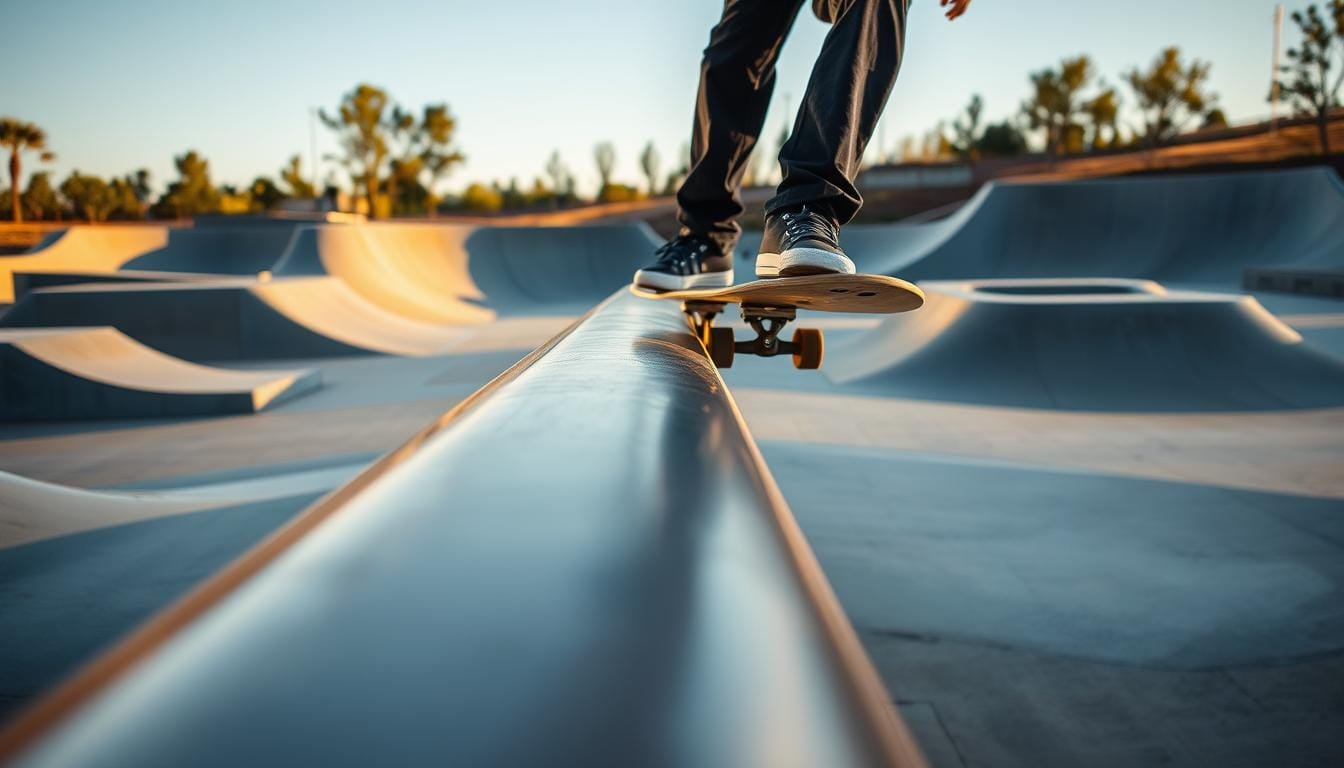Choosing the right skate rail length is key for nailing skateboard rail tricks. Many skaters go for a standard 10-foot rail. It’s long enough for a range of grinds and slides. This length hits the sweet spot between being challenging and practical.
Shorter rails, like 8 feet, might look small but are pretty handy. They’re good for practicing new moves or when space is tight. Also, they make it easier to stop a trick and recover if you land awkwardly. So, knowing about grinding rail size can really help you skate better.
Putting rails in can make a spot 30% smoother, letting you skate without so much wax. That means less time and money spent on upkeep. Rails also make longer slides possible, like boardslides, by up to 20%. For tips on grinds, see this in-depth guide here.
Key Takeaways
- A 10-foot rail is generally optimal for a wide range of tricks.
- Shorter rails, around 8 feet, are more manageable for beginners.
- Rails can improve surface smoothness by 30% and slide distance by 20%.
- Using rails reduces the need for wax by up to 50%, saving on maintenance costs.
- Rails add minimal weight to your skateboard, affecting performance to a negligible extent.
Understanding the Skate Rail Basics
Skateboard rails help you do sliding tricks with style and accuracy. There are many shapes and sizes, suited for various skating levels. The most seen types are straight, angled, curved, and kinked rails. Each kind has unique challenges and needs special skills.
For beginners, rectangular skateboard rails are the go-to. They’re about 4 inches wide on top and 2 inches on the sides. This size gives more stability, helping new skaters learn how to grind and slide.
On the other hand, round rails are thinner, about 2 1/4 inches wide. These require more balance and are chosen by skilled skaters who want a challenge. The design of grinding rails has changed how skaters tackle these obstacles.
To better grasp skate rail types, let’s explore their unique features:
| Rail Type | Shape | Ideal For |
|---|---|---|
| Rectangular | Flat Top | Beginners |
| Round | Slender | Advanced Skaters |
| Kinked | Multiple Angles | Intermediate to Advanced |
| Curved | Smooth Curves | Advanced Techniques |
The design and range of skateboard rails are key to improving your skills. Knowing about different rails helps you pick the right one, no matter your skill level.
Why Rail Length Matters for Performance
Skate rail length is key to doing better tricks. A longer rail gives you more room for grinds and slides. It should be at least 6 feet for good tricks. But for tougher tricks, go for 8 feet or more.
Long rails help skaters do complex moves easily. They lead to better control and more efficient skateboarding. The shape of the rail also plays a big role. Whether it’s angled, curved, or straight changes how hard it is to skate.
Skateboard deck rails have come a long way since the 70s and 80s. They are now made from tough UHMW material. Rails should be placed 1 to 1.5 inches off the deck edge for the best performance. Keeping them tight and in good shape is crucial for safe skating.
| Deck Width (Inches) | Shoe Size (US) |
|---|---|
| 7.5” – 7.875” | 4 |
| 8.125” – 8.5” | 10 |
| 8.5” and up | 14 |
In conclusion, having the right rail is more than just the length. It includes the material, design, and upkeep, too. The right rails can really improve your skating.
Ideal Skate Rail Length for Beginners
When you’re starting skateboarding, picking the right rail is key. Choosing the correct rail length is critical for beginners. Short skate rails around 6 feet long are best. They offer enough room for basic tricks but are still easy to handle.
Shorter rails are safer for new skaters. They let beginners practice with ease and gain confidence. With heights between 9″-18″, they meet various needs. But 12″-15″ is best for doing tricks.
| Parameter | Recommendation |
|---|---|
| Ideal Height | 9″-18″ |
| Optimal Trick Height | 12″-15″ |
| Minimum Grinding Length | 6′ |
| Portable Rail Length | 6′ |
| Standard Rail Diameter | 2 1/4″ |
| Cost | $249 – $349 |
Understanding beginner skate rail basics is vital as you get better. So, tighten those screws. Get ready to land your first tricks with sureness!
Optimal Rail Length for Intermediate Skaters
As you get better at skateboarding, your rail’s length becomes very important. For those at an intermediate level, a 10-foot long rail is best. It strikes the right balance, helping you to do harder tricks, like grinds and slides, over longer stretches.
Finding the right rail length is key for building your skills. Rails that are 8 to 10 feet long are perfect for intermediates. They’re not too easy but not too hard. They help you move from beginner rails (4-6 feet) to pro rails (12 feet or more) smoothly.
Here’s why 10 feet is the magic number:
| Experience Level | Recommended Rail Length |
|---|---|
| Beginner | 4-6 feet |
| Intermediate | 8-10 feet |
| Professional | 12 feet or more |
By choosing the right length for skate rails, you keep getting better in a fun way. Whether it’s grinding with more accuracy or feeling more confident on longer slides. Picking the right rail size is crucial for continuous improvement.
Advanced Rails for Experienced Skaters
For skaters who love a challenge, advanced skate rails are key. They can be up to 20 feet long. This roominess allows for all sorts of complex tricks. When picking a skate rail, think about what the skater needs and knows.
Customizing skate rails adds a whole new level of challenge. You can change the height or add curves and kinks. For those aiming to test their limits, these options are golden.
Skateboard deck rails are making a comeback. They first showed up in the 1980s and are cool again now. Skaters into slappy tricks and street skating find these rails crucial for better control.
Sites like Doctor Skate have good tips on setting up your skate. Deck rails now not only look good but also help your slides and make the board last longer. They are a must-have for skilled skaters.
| Advanced Skate Rails | Features | Benefits |
|---|---|---|
| Length (10-20 feet) | Ample space for tricks | Enhanced trick variety and performance |
| Variable height | Custom height configurations | Added challenge and versatility |
| Kinked/Curved sections | Complex rail designs | Greater trick possibilities |
| Deck rail resurgence | Protection, precision, durability | Smoother slides, preserved graphics |
In short, advanced skate rails help skaters grow and try new things. Their length, ability to be customized, and the benefits of deck rails are crucial. They’re a big plus for anyone serious about skateboarding.
Customizing Your Skate Rail
Custom skate rails let you create a setup that’s just right for you. It’s perfect whether you’re building skateboard rails from scratch or improving what you have. Pick the right length, shape, and materials—crucial steps. Making a basic custom rail might cost around $150. This price lets you try things out without spending too much. Wood, metal, and plywood are popular choices, each with good and bad points. Wood is cheaper but can get damaged by the weather, while metal is strong but pricier.
When making changes, think about options like adjustable heights or removable feet for moving it easily. Skaters often have favorite rail shapes, like straight, angled, or curved, to suit their tricks. Some even fill their rails with spray foam to lower noise. Plus, it’s important to keep your rail safe from theft, especially outside. Adding locks is a smart move.
Though cost might stop some, making your own skateboard rails is a cheaper way. Using old or repurposed materials can save money and help the planet. Taking on DIY projects means you control the rail’s design, making sure it suits your skills and tricks.
| Material | Pros | Cons |
|---|---|---|
| Wood | Readily available, inexpensive | Can deteriorate over time |
| Metal | Extremely durable | Expensive, requires specialized tools |
| Plywood | Smooth surface, affordable | Susceptible to water damage |
Buying custom skate rails or starting a DIY skateboard rails project requires good planning. Make a list of what you need and check prices to get the best deal. Taking care of your rail will make it last longer, so you can enjoy skateboarding even more.
Maintaining Your Skate Rail
Keeping your skate rail in tip-top shape is key for safe and fun skating. It’s important to regularly check your rail for any damage or wear. This includes looking for rust, checking if bolts are tight, or if the rail shape is off.
Cleaning your skate rail is also a must-do. Just wiping it with a wet cloth can remove dirt that might harm it over time. If you see rust, scrub it off with a wire brush. Adding some lubricant will keep the rail from rusting again. Sometimes, you might need to refinish the rail so it’s smooth for grinding.
It’s also vital to ensure every part of the rail is firmly attached. Bolts and supports can get loose, making the rail wobbly. Check and tighten them to make sure your rail stays safe to use. A skateboard tool can make this job easier for you.
Taking some time to care for your skate gear can make your rail last longer and work better. No matter if you are new to skating or have been doing it for years, looking after your rail lets you skate safely. It also ensures you have a solid rail for practicing tricks.

I’m John Peterson, a passionate skater, blogger, and lifelong enthusiast. I’ve been skating for over 9 years and have gone on to write a blog dedicated to the sport of skating and its culture. Through my blog, I strive to share my knowledge and experience of the sport with all who are interested. From beginner tips, tricks, and equipment reviews to interviews and event coverage, I cover it all. So read my blog as I explore the wonderful world of skating!

